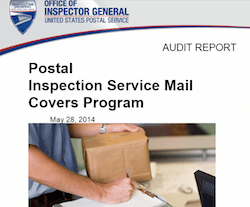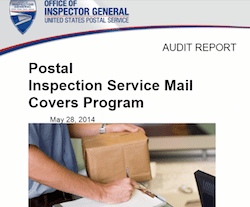
The United States Postal Service disclosed it approved nearly 50,000 requests, called “mail covers,” last year alone from law enforcement to secretly monitor the snail mail of Americans.
An audit shows the surveillance program is more extensive than widely known and that oversight protecting Americans is lax: 21 percent of the covers examined were approved without even the minimal required written authorization and 13 percent that did have authorization “were not adequately justified.” The Post Office has no standing review procedures.
Mail Cover is Nothing New, But…
The Post Office helping spy on Americans per se is nothing new; its program to record your mail’s “metadata,” who sent what to whom, complete with addresses and date/time stamps, has existed in the form of an overt program detailed in federal law called “mail cover” since well before the term metadata was even invented. As mail cover does not involve reading the mail’s contents, only information on the outside of the envelope or package that could be read by anyone seeing the item, it is not considered by precedent a violation of the Fourth Amendment’s protections against unwarranted searches.
Official versions of mail cover are acknowledged as far back as World War I. But like many such things– wiretapping, border detentions, searches and seizures, old Executive Orders, signing statements– its former existence, restrained in theory and often in practice in Constitutional America, is largely irrelevant now to all but historians. What has happened post-9/11 to mail covers is what has happened to America.
How Did Mail Cover Use to Work?
A mail cover has to be requested by a state or federal law enforcement agency. Following internal approval, postal workers intercept the target’s mail before delivery, and record the names, return addresses and any other information from the outside of letters and packages before they are delivered to a person’s home. The Post Office does not notify the recipient or the sender that the cover is in place.
Prior to 9/11, the process had an old-timey feel to it, almost quaint. In a 2006 leaked instruction manual, agencies seeking a mail cover were told to first fill out a paper form, the External Law Enforcement Request for Mail Cover Template. Law enforcement was reminded to include the Zip +4 for all subjects. An electronic version of the form was supposedly available, but you had to telephone the Post Office personally to get one.
The template required a paper cover letter requesting the action on agency letterhead, signed by the requesting agent’s supervisor. The form would then need to be put into an envelope marked Restricted Information, with that sealed inside a second envelope, and then snail-mailed via the regular first class, unclassified, mail system, to the appropriate section of the Post Office. Information obtained by the Post Office would be sent back on a Form 2009.
Implementation was largely also a paper process. One subject learned his mail was being covered after he received a handwritten card, apparently delivered by mistake, with instructions for postal workers to pay special attention to the letters and packages sent to his home. “Show all mail to supv for copying prior to going out on the street,” read the card. The word “confidential” was highlighted in green. Another subject was told he was being covered by his regular mail delivery person.
The standards for law enforcement to request a mail cover were low; “reasonable grounds that demonstrate the information from the mail cover is necessary to develop evidence in a criminal investigation.” Covers were not to be used as the first step in an investigation (on an honor system) and could not include attorney-client mail if the attorney of record is known (on an honor system.)
The key point is that absent a specific request to monitor a specific person, the mail was simply delivered as it had been since the time of the pony express.
Mail Isolation Control and Tracking (MICT)
Sometime after the anthrax attacks of 2001, when the mail was used to send the poison letters, and its public acknowledgement is 2013, the Post Office created the Mail Isolation Control and Tracking (MICT) system.
Under the new MICT system, an imaging tool is used to photograph of the exterior of every piece of paper mail processed in the United States. The images are kept, the Post Office says, for 30 days, allowing them to retroactively track mail at the request of law enforcement. There are no stated limits on how long law enforcement may store any information they receive from the Post Office. In addition, mail covers can be extended indefinitely, meaning a flow of data-in for years can be done if desired. MICT is the companion program to the NSA’s efforts: collect everything, store it, and then dig in retroactively. As has been said of the NSA , why look for the needle now, when you can collect the whole haystack? Collect it all, tag it, store it and later, whatever it is you want, search for it.
Like the metadata obtained from cell phone records, mail covers are “a treasure trove of information,” James Wedick, a former FBI agent, told the New York Times. “Looking at just the outside of letters and other mail, I can see who you bank with, who you communicate with, all kinds of useful information that gives investigators leads that they can then follow up on with a subpoena.”
As for those subpoenas, and any warrants thought to be needed to actually open and read mail of interest, George W. Bush asserted in a 2007 signing statement that the federal government had the authority to open mail without warrants in emergencies or in foreign intelligence cases. Others have argued such authority has existed since 1978 as part of the original FISA legislation.
Abuse
It should be blindingly obvious how the mail cover system, particularly with the broad, digital sweep of MICT available, stands ready to be abused (examples of past abuses are the alternate, secret, mail cover program [HTLINGUAL] run for twenty some years by the CIA, and the FBI’s COUNTERINTELPRO work against Vietnam War opponents.) The current mail cover system operates under no judicial or outside oversight. It relies on numerous assertions, an honor system if you will, by law enforcement that the Post Office cannot verify. The system touches the mail of every American.
How many Americans have their mail subjected to this scrutiny? In 2013 alone, the Postal Office processed about 50,000 mail covers.
Abuse? A sample examined by the Postal Service Office of Inspector General (OIG) “found some controls lacking.” For example, 21 percent of the covers examined were approved without even the minimal required written authorization and 13 percent that did have paper requests “were not adequately justified.” The audit also found hundreds of mail covers in active status even though their cover periods had ended. Part of the problem is that the Post Office has no standing review procedures for its own program.
Other than the referenced OIG report, the Post Office refuses to disclose how many requests for mail covers it has received, nor will it break down the requests by local law enforcement versus federal law enforcement, nor will it specify how many requests are related to criminal investigations and how many deal with national security investigations. In fact, the Post Office has provided false information to some of those questions to the media.
Conclusion
On a oddly positive note, the Postal Service Office of Inspector General’s report did find handling of mail cover requests tended to be sloppy and slow, and the case management software ineffective. Such are the things that stand now between Americans and the Post-Constitutional Dark State.
While small in size compared to the global operations of the NSA, the Post Office mail cover program shares many of the same hallmarks. It grew in size, complexity and technology post-9/11 without adequate safeguards built in, and has operated without those safeguards ever since. It is a secret program affecting all Americans, only disclosed by accident, Freedom of Information Act requests and a few journalists willing to look into the government’s actions. The program moved very quickly from targeting a select few Americans to covering every one of us. Like the actions of the NSA against Americans, the mail cover program at the very least rubs rough against the edges of the Fourth Amendment’s guarantees against unlawful searches, relying on legal precedents created in another era while using secrecy to thwart new legal challenges.
There are the “it’s just metadata” faux arguments. Can’t someone look over my shoulder at the Post Office anyway? Big deal. Actually, it is a big deal. What is significant about the many disparate elements of a global surveillance system is not pieces of data in isolation (I got a letter today) but how those small elements can be combined to create a comprehensive picture of someone. Location data from phones + credit card transactions + license plate trackers + text messages sent and received + pharmacy purchases + Facebook posts + mail sent and delivered… well, you get it.
And on perhaps a more personal note, one is left thinking, aw c’mon, now the Post Office too? The Post Office used to be one of the good guys, bringing packages and Christmas cards, creating a kind of a miracle that for about half a buck, a letter with details of Aunt Tillie’s surgery could journey from Ohio to Montana in just a few days. At some level, a lot of Americans were long-suspicious of the NSA, CIA. Sadly, post-9/11, the Post Office now too is just another tool of the surveillance state.
Posted with author’s permission from his blog, We Meant Well.

